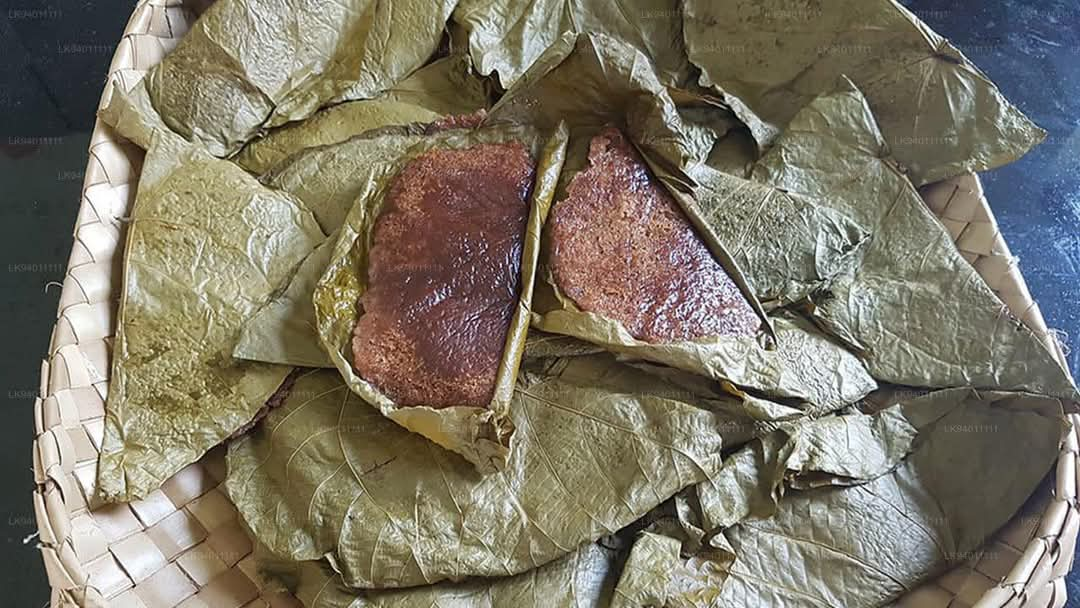Currently Empty: $0.00

December 8, 2024
0 Comments
Halapa: A Traditional Sri Lankan Treat
Halapa is a cherished Sri Lankan sweet that has been passed down through generations. Made from ragi flour (kurakkan flour), grated coconut, and kithul treacle (or sugar), this treat is a favorite snack enjoyed throughout the island. Often wrapped in kenda leaves and steamed, Halapa is known for its soft, chewy texture and unique flavor profile, making it a go-to energy-boosting snack.
A Taste of Tradition
Halapa isn’t just a snack; it’s a piece of Sri Lanka’s rich culinary heritage. For centuries, it has been enjoyed by families during festivals, ceremonial events, and special occasions. It’s especially popular during the Sri Lankan New Year (Avurudu), when families prepare a variety of traditional sweets to share with relatives and neighbors.
The key ingredients of Ragi flour (also known as Kurakkan flour) and kithul treacle reflect Sri Lanka’s agricultural bounty. Ragi, a highly nutritious grain, has been grown in Sri Lanka for centuries, particularly in the dry zone, where it is a staple food. The sweetener, kithul treacle, is harvested from the sap of the kithul palm tree, a vital resource in Sri Lanka’s rural communities. The treacle is a deep, rich syrup with a smoky flavor that adds complexity to Halapa’s taste.
The Role of Kenda Leaves
An essential part of making Halapa is the use of kenda leaves (also known as pandan leaves or banana leaves in some areas), which are used to wrap the dough before steaming. These leaves serve two important purposes: first, they hold the dough together while it’s steamed, and second, they impart a subtle fragrance to the sweet treat. The distinct smell of the leaves adds a layer of earthy flavor to the Halapa that can’t be replicated by other methods.
When unwrapping the leaf after steaming, there’s a unique sense of anticipation. The leaf has a slightly bitter note that contrasts beautifully with the sweetness of the coconut and kithul treacle, providing a delightful balance of flavors.
Halapa is a Symbol of Community and Culture
Making Halapa is often a communal activity. In the past, families and neighbors would come together to prepare and share the treat. The process of collecting kenda leaves, mixing the ingredients, and steaming the Halapa was often done as a group effort. This sense of togetherness is deeply ingrained in Sri Lankan culture, where food plays a central role in community bonding.
Halapa is also a part of many local festivals and celebrations. Its presence at special occasions reflects Sri Lanka’s tradition of hospitality, where food is offered as a symbol of goodwill and generosity. Whether shared among family members or given as a gift to guests, Halapa is a treat that fosters unity and connection.
A Versatile Treat
Halapa comes in different variations, and you can adjust the recipe according to personal taste. Some versions include a coconut filling for added richness, while others stick to the basic mixture of flour, coconut, and sweetener. Some people even use date paste or honey as a substitute for kithul treacle. Regardless of the specific ingredients used, the essence of Halapa remains the same—a sweet, energy-boosting treat that is deeply rooted in Sri Lankan culture.
Halapa Today
Though its preparation may have evolved with time, Halapa continues to be a beloved treat in Sri Lankan households. In modern times, Ragi flour is often easily available in supermarkets, and kithul treacle can be found in specialty shops, making it easy to recreate this traditional treat at home. Despite its humble ingredients, Halapa remains a favorite snack, often enjoyed with a cup of tea or as a quick bite after a workout for an instant energy boost.
Halapa is not just a food; it is a link to the past, a reminder of simpler times when food was made with love, shared with others, and celebrated as part of the island’s rich cultural identity. Whether you make it yourself, buy it from a local vendor, or enjoy it at a family gathering, Halapa is a timeless treat that will continue to hold a special place in the hearts of Sri Lankans for generations to come.
#madebysrilankan #madeinsrilanka #vigtravel ❤️🇱🇰
📸 credit to photographer


